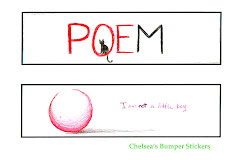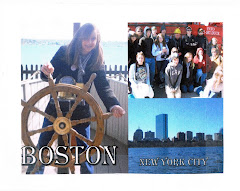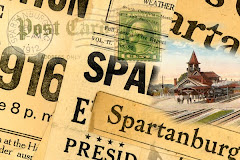
A Geographical Tour of Literary America
The Grand Tour of Literary Landmarks resulted from my students' success with another project that we called "Poetic License with THE AMAZING RACE." This new journey also begins and ends in my students' hometown. Chosen writers are specific to our curriculum and texts; however, teachers can adapt new selections to their students' needs. Side images are their original work. Photo images at each destination go directly to official sites or to the slideshows of my own travel photos. The main sources of written material here are www.Poets.org and Adventures in American Literature, Heritage Edition and Pegasus Edition.
Spartanburg, South Carolina

Hello from Spartanburg, South Carolina - my hometown!
Go to Hub City Writers Project . Study the web site and then report on its purpose, press, and bookstore.
Be sure to answer these questions:
What is Hub City Writers Project?
What creative writing workshops are being offered in the next two months?
Name three poetry books that Hub City Writers Project has available currently?
Start here on the literary map!
What is Hub City Writers Project?
What creative writing workshops are being offered in the next two months?
Name three poetry books that Hub City Writers Project has available currently?
Start here on the literary map!
Columbia, South Carolina

On the literary map, travel from Spartanburg to Columbia, South Carolina.
Calculate:
# _____________ Miles to Columbia, South Carolina
$ _____________ Cost for Gasoline to Columbia, South Carolina
Read about Henry Timrod and "Ode on the Confederate Dead."
Explain the symbol in line 3.
Explain the allusion in line 8.
What is an ode?
What words and phrases convey a religious feeling?
In this ceremony the living pay honor to their fallen soldiers. Which lines in the poem indicate that this simple tribute is more appropriate than the monuments that will later be placed here?
Charleston, South Carolina
 On the literary map, travel from Columbia to Charleston, South Carolina.
On the literary map, travel from Columbia to Charleston, South Carolina.Calculate:
# _____________ Miles to Charleston, South Carolina
$ _____________ Cost for Gasoline to Charleston, South Carolina
Charleston, South Carolina is the birthplace of Henry Timrod.
Read "Charleston" by Henry Timrod (1829-1867).
Calm as that second summer which precedes
The first fall of snow,
In the broad sunlight of heroic deeds,
The city bides the foe.
As yet, behind their ramparts, stern and proud,
Her bolted thunders sleep, --
Dark Sumter, like a battlemented cloud,
Looms o'er the solemn deep.
No Calpe frowns from lofty cliff or scaur
To guard the holy strand;
But Moultrie holds in leash her dogs of war
Above the level sand.
And down the dunes a thousand guns lie couched,
Unseen, beside the flood, --
Like tigers in some Orient jungle crouched
That wait and watch for blood.
Meanwhile, through streets still echoing with trade,
Walk grave and thoughtful men,
Whose hands may one day wield the patriot's blade
As lightly as the pen.
And maidens, with such eyes as would grow dim
Over a bleeding hound,
Seem each one to have caught the strength of him
Whose sword she sadly bound.
Thus girt without and garrisoned at home,
Day patient following day,
Old Charleston looks from roof and spire and dome,
Across her tranquil bay.
Ships, through a hundred foes, from Saxon lands
And spicy Indian ports,
Bring Saxon steel and iron to her hands,
And Summer to her courts.
But still, along yon dim Atlantic line,
The only hostile smoke
Creeps like a harmless mist above the brine,
From some frail, floating oak.
Shall the Spring dawn, and she, still clad in smiles,
And with an unscathed brow,
Rest in the strong arms of her palm-covered isles,
As fair and free as now?
We know not; in the temple of the Fates
God has inscribed her doom;
And, all untroubled in her faith, she waits
The triumph or the tomb.
Jacksonville, Florida
On the literary map, travel from Charleston, South Carolina, to Jacksonville, Florida.
Calculate:
# _____________ Miles to Jacksonville, Florida
$ _____________ Cost for Gasoline to Jacksonville, Florida
Visit James Weldon Johnson at www.Poets.org and fill-in-the-blanks.
"James Weldon Johnson was born in _______ in Jacksonville, Florida. He was encouraged to study English literature and the European musical tradition. He attended Atlanta University with the intention that the education he received there would be used to ________________. After graduation, he took a job as __________________________________________."
"In 1900, he wrote the song 'Lift Ev'ry Voice and Sing'" on the occasion of Lincoln's birthday; the song which became immensely popular in the black community and became known as the '_____________________________.' Johnson moved to New York in 1901 to collaborate with his brother Rosamond, a composer, and attained some success as a songwriter for Broadway, but decided to take a job as U.S. Consul to Venezuela in 1906. While employed by the diplomatic corps, Johnson had poems published in the Century Magazine and The Independent."
"In 1912, Johnson published The Autobiography of an Ex-Colored Man under a pseudonym, the story of a musician who rejects his black roots for a life of material comfort in the white world. The novel explores _______________________________________________, a common theme in the writing of the _________________________________."
"He had a talent for persuading people of differing ideological agendas to work together for a common goal, and in 1920 he became the national organizer for the National Association for the Advancement of Colored People (NAACP). He edited The Book of American Negro Poetry (1922), a major contribution to the history of African-American literature. His book of poetry ___________________(1927) was influenced by his impressions of the rural South, drawn from a trip he took to Georgia while a freshman in college. It was this trip that ignited his interest in the African-American folk tradition."
Read "The Creation" and "Lift Ev'ry Voice and Sing."
Calculate:
# _____________ Miles to Jacksonville, Florida
$ _____________ Cost for Gasoline to Jacksonville, Florida
Visit James Weldon Johnson at www.Poets.org and fill-in-the-blanks.
"James Weldon Johnson was born in _______ in Jacksonville, Florida. He was encouraged to study English literature and the European musical tradition. He attended Atlanta University with the intention that the education he received there would be used to ________________. After graduation, he took a job as __________________________________________."
"In 1900, he wrote the song 'Lift Ev'ry Voice and Sing'" on the occasion of Lincoln's birthday; the song which became immensely popular in the black community and became known as the '_____________________________.' Johnson moved to New York in 1901 to collaborate with his brother Rosamond, a composer, and attained some success as a songwriter for Broadway, but decided to take a job as U.S. Consul to Venezuela in 1906. While employed by the diplomatic corps, Johnson had poems published in the Century Magazine and The Independent."
"In 1912, Johnson published The Autobiography of an Ex-Colored Man under a pseudonym, the story of a musician who rejects his black roots for a life of material comfort in the white world. The novel explores _______________________________________________, a common theme in the writing of the _________________________________."
"He had a talent for persuading people of differing ideological agendas to work together for a common goal, and in 1920 he became the national organizer for the National Association for the Advancement of Colored People (NAACP). He edited The Book of American Negro Poetry (1922), a major contribution to the history of African-American literature. His book of poetry ___________________(1927) was influenced by his impressions of the rural South, drawn from a trip he took to Georgia while a freshman in college. It was this trip that ignited his interest in the African-American folk tradition."
Read "The Creation" and "Lift Ev'ry Voice and Sing."
Key West, Florida
 On the literary map, travel from Jacksonville to Key West, Florida.
On the literary map, travel from Jacksonville to Key West, Florida.Calculate:
# _____________ Miles to Key West, Florida
$ _____________ Cost for Gasoline to Key West, Florida
Visit "The Poet Homes of Key West, Florida" at www.Poets.org
Visit Elizabeth Bishop at www.Poets.org and fill-in-the-blanks.
"Elizabeth Bishop was born in Worcester, Massachusetts. When she was very young her father died, her mother was committed to a mental asylum, and she was sent to live with her grandparents in Nova Scotia. She earned a bachelor's degree from Vassar College in 1934."
She was independently wealthy, and from 1935 to 1937 she spent time __________ to France, Spain, North Africa, Ireland, and Italy and then settled in Key West, Florida, ___________. Her poetry is filled with _________________________________________________, as with the Florida poems in her first book of verse, North and South, published in 1946."
"She was influenced by the poet _______________, who was a close friend, mentor, and stabilizing force in her life. Unlike her contemporary and good friend Robert Lowell, who wrote in the 'confessional' style, Bishop's poetry avoids _____________________________, and focuses instead with great subtlety on her impressions of the physical world."
Read "Filling Station," and listen to "The Armadilla" as you follow along.
Read "The Fish" and answer the questions.
I caught a tremendous fish
and held him beside the boat
half out of water, with my hook
fast in a corner of his mouth.
He didn't fight.
He hadn't fought at all.
He hung a grunting weight,
battered and venerable
and homely. Here and there
his brown skin hung like strips
like ancient wall-paper,
and its pattern of darker brown
was like wall-paper:
shapes like full-blown roses
stained and lost through age.
He was speckled with barnacles,
fine rosettes of lime,
and infested
with tiny white sea-lice,
and underneath two or three
rags of green weed hung down.
While his gills were breathing in
the terrible oxygen
-the frightening gills,
fresh and crisp with blood,
that can cut so badly -
I thought of the coarse white flesh
packed in like feathers,
the big bones and the little bones,
the dramatic reds and blacks
of his shiny entrails,
and the pink swim-bladder
like a big peony.
I looked into his eyes
which were far larger than mine
but shallower, and yellowed,
the irises backed and packed
with tarnished tinfoil
seen through the lenses
of old scratched isinglass.
They shifted a little, but not
to return my stare.
-It was more like the tipping
of an object toward the light.
I admired his sullen face,
the mechanism of his jaw,
and then I saw
that from his lower lip
-if you could call it a lip-
grim, wet and weapon-like,
hung five old pieces of fish-line,
or four and a wire leader
with the swivel still attached,
with all their five big hooks
grown firmly in his mouth.
A green line, frayed at the end
where he broke it, two heavier lines,
and a fine black thread
still crimped from the strain and snap
when it broke and he got away.
Like medals with their ribbons
frayed and wavering,
a five-haired beard of wisdom
trailing from his aching jaw.
I stared and stared
and victory filled up
the little rented boat,
from the pool of bilge
where oil had spread a rainbow
around the rusted engine
to the bailer rusted orange,
the sun-cracked thwarts,
the oarlocks on their strings,
the gunnels - until everything
was rainbow, rainbow, rainbow!
And I let the fish go.
In “The Fish,” the speaker examines the old fish closely. What is its brown skin compared to in lines 9 – 15? What details make this comparison effective?
How is the inside of the fish described?
The old fish is viewed as a kind of war veteran. How does the comparison in lines 47 – 61 reinforce this idea? Whose “victory” is the speaker talking about in lines 66-67?
Subscribe to:
Comments (Atom)



















